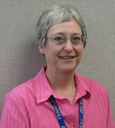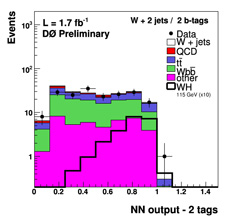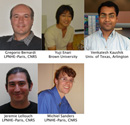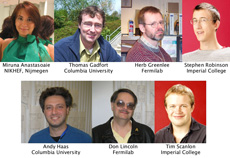|
Thursday, Sept. 20
1 p.m.
CANCELLED: ILC ALCPG Physics and Detector R&D Seminar - West Wing, WH-10NW
To be rescheduled for next week.
Speaker: C. Gatto, INFN
Title: Tracking Studies for the ILC
2:30 p.m.
Theoretical Physics Seminar - Curia II
Speaker: R. Rückl, Universität Würzburg
Title: SUSY Lepton Flavor Violation: Radiative Decays and Collider Searches
3:30 p.m.
DIRECTOR'S COFFEE BREAK - 2nd Flr X-Over
THERE WILL BE NO ACCELERATOR PHYSICS AND TECHNOLOGY SEMINAR TODAY
Friday, Sept. 21
3:30 p.m.
DIRECTOR'S COFFEE BREAK - 2nd Flr X-Over
4 p.m.
Joint Experimental-Theoretical Physics Seminar - One West
Speaker: J. Collar, University of Chicago
Title: COUPP, a Dark Matter Search at FNAL: Status and First Results
Click here for NALCAL,
a weekly calendar with links to additional information.
|
Thursday, Sept. 20
- Minnesota wild rice w/chicken
- Tuna melt on nine grain
- BBQ ribs
- Chicken casserole
- Buffalo chicken wrap
- Assorted slice pizza
- Toasted pecan chicken salad
*Carb restricted alternative
Wilson Hall Cafe menu |
|
Thursday, Sept. 20
Dinner
- Grilled sea scallops w/maple cream
- Rack of lamb
- Celery root & potato mash
- Vegetable of the season
- Almond, yogurt & olive oil cake
Wednesday, Sept. 26
- Cheese ravioli w/tomato basil cream
- Italian chopped salad
- Apple walnut turnovers
Chez Leon menu
Call x4598 to make your reservation. |
|
|
Linda Stutte retires Sept. 21
 |
| Linda Stutte |
When Linda Stutte arrived at Fermilab in 1972, she knew that she was at the forefront of discovery.
"All of the exciting physics was on the horizon," Stutte said. "This was the place to be."
Stutte has helped keep Fermilab a leader in high-energy physics through software and hardware development, neutrino-beam research and management of the DZero experiment. When she retires Sept. 21 after 35 years, she will leave a legacy of hard work and discovery.
"Linda has made many contributions to Fermilab over her 35 years as a scientist," said Gene Fisk, DZero deputy department head. "In the early days, she became an expert on neutrino beams and was one of the few physicists who could tune the Neutrino Area beams that provided data for the bubble chambers and the large neutrino experiments. She participated in the construction of E594, managed the DAQ system and wrote much of the early pattern recognition software."
As the laboratory grew, so did Stutte's role. She headed the team of scientists who built a ring-imaging Cerenkov detector to identify particle types for the SELEX experiment, a charmed baryon fixed-target experiment.
Stutte continually sought out projects with unique challenges or that played pivotal roles in expanding the understanding of physics. She was elevated to department leader of DZero in 2002.
"During the last 10 years, Linda used her expertise to help manage the upgrades of DZero's forward muon system," Fisk said. "When the hardware was installed she turned her attention to the DZero software that continues to monitor the physics performance of our muon system."
As department head, Stutte oversees the experiment budget and the Fermilab employees. She's the oil that keeps the department moving smoothly and personalities clicking. "We try to make sure our people have challenging and enjoyable projects," she said. "There are so many different things going on, there always is something that interests them." Stutte's management style reflects her own career philosophy: "My main idea was to have fun, and I did."
Stutte plans to continue with the DZero experiment. She also plans to stay involved with DZero editorial boards.
You can bid Stutte good-by with cake and refreshments at 3 p.m. Friday, Sept. 21, in the DZero assembly hall.
-- Haley Bridger
|
symmetry posters available
 |
| symmetry May 2007 issue |
The May 2007 cover of symmetry, featuring illustrations by New Yorker
cartoonist Roz Chast, is so popular that we've made it into a poster. Stop
by the Office of Communications, WH1E, to pick up a copy for yourself or a
friend.
|
ATLAS: the data chain works

Tracks recorded in the muon chambers of the ATLAS detector now can be expressed to physicists all over the world, enabling simultaneous analysis at sites across the globe. European and U.S. sites are connected via the Enabling Grids for E-sciencE and Open Science Grid infrastructures.
Image courtesy of ATLAS
This month particle physics experiment ATLAS went "end-to-end" for the first time.
Buried in Switzerland, 90 meters under the ground at the base of the French Jura mountains, ATLAS (A Torroidal LHC ApparatuS) is one of four high energy physics experiments attached to the Large Hadron Collider, a 27-kilometer particle accelerator nearing the final stages of completion.
Read More
|
European scientists prepare to test the limits of physics
From European Research Committee, Sept. 18, 2007
European scientists are gearing up for a series of experiments that will probe deeper into the nature of matter than ever before. At the end of August the Scientific Information Port (PIC), a centre for technology based at the Universitat Autonoma de Barcelona (UAB) began work on the first stage of the European project Large Hadron Collider (LHC). The aim of the project is to study the origins of matter by reproducing conditions similar to those produced during the Big Bang. The PIC, as well as other computational centres around the world, began receiving data concerning cosmic rays collected using Atlas, a large ''general purpose'' particle detector. This information is to be used to test the system before the LHC starts up in the spring of 2008.
This exercise was the first time that data from the LHC was sent in real time to centres outside of CERN and information regarding ten million events (particle collisions) has been stored. Once the data has been processed it will be used to test the acquisition, distribution and detection systems and to refine the calibration parameters of the detector before it begins operation in April 2008. The data originates from experiments on particle acceleration and collision.
Read more
|
|
|
Spotlight on Higgs

This figure shows the artificial neural network discriminant value for events with a W boson and two tagged b-quark jets. Included in the figure are observed data events, simulated backgrounds, and a hypothetical Higgs boson signal with m_H=115 GeV/c2. The ANN provides a more powerful separation of signal and background than traditional "cut-based" techniques.
Forty-three years ago, Peter Higgs published a short paper in "Physics Letters" that led to a solution to one of the most puzzling questions of particle physics: Why do elementary particles have mass? The Higgs mechanism predicts the existence of a particle now known as the Higgs boson, but is silent on its exact mass. So far, the Higgs boson has thwarted all attempts for its discovery. Undaunted, physicists at the DZero experiment have decided to build a bigger and better searchlight to find the Higgs boson.
If the Higgs boson exists, proton-antiproton collisions at the Tevatron, which is performing at ever-increasing luminosity, would produce up to six Higgs bosons per day. Unfortunately, nearly all of these are either buried directly under an immense pile of nearly-identical non-Higgs events or are simply not detected because the detector is overwhelmed by the number of events. To shine a light on possibly missed Higgs bosons, DZero researchers worked hard to improve the detection efficiency for Higgs-like events. To build a better spotlight, they had to find a new way to identify Higgs events, rather than simply categorizing them by their distinguishing features. By using artificial neural networks, DZero scientists have improved their ability to separate signal from background. When distinguishing objects, these ANNs behave much like a human brain by considering many features simultaneously.
The DZero collaboration has recently released new results on the search for the Higgs using 1.7 inverse femtobarns of data. The most sensitive channel for a light Higgs is the one where the Higgs, decaying into two bquarks, is accompanied by a W boson. Using their ANNs to sift through the data, DZero researchers have set the tightest limits on associated W-boson-plus Higgs production to date with a sensitivity less than 10 times the predicted production rate at a Higgs mass of 115 GeV/c^2. Although this result means the Higgs boson continues to elude the spotlight, DZero researchers are tirelessly continuing the work begun 43 years ago. By combining their results with those of their CDF colleagues, they plan to discover the Higgs boson or set the tightest limits on its existence.
 |
Primary contributitors to this analysis: Gregorio Bernardi, Yuji Enari, Venkatesh Kaushik, Jeremie Lellouch, and Michiel Sanders. |

The DZero bquark identification group works hard to ensure reliable and efficient selection of bquarks. The B-ID process is essential for the success of analyses such as this one, which includes heavy-flavor quarks in its selection.
Result of the Week Archive
|
|
Have a safe day!
Women scientists' lunch today
A lunch will be held today for women scientists working at Fermilab. This monthly activity provides an excellent opportunity to meet Fermilab colleagues from different divisions and experiments. This month's lunch will be held at 12:15 p.m., at Venice Tavern, 31 N. River St., Batavia.
Reservations can be made by contacting Supriya Jain. To receive notifications of upcoming activities and networking opportunities E-mail the Women scientist mailing list.
NALWO Annual Autumn Luncheon Sept. 24
NALWO's Annual Autumn Luncheon will be held Monday, Sept. 24, from 11:30 a.m. to 1 p.m. at Chez Leon in the User's Center. All laboratory women and friends are invited to attend. Come and meet each other, plan the coming season's activities, and enjoy international dishes. Please bring a dish to share. For additional information, contact the Housing Office or Rose Moore at (630) 208-9309.
Register for ALCPG07
The joint meeting of the American Linear Collider Physics Group and ILC
Global Design Effort will take place at Fermilab Oct. 22-26. The
deadline to register is Oct. 12. Questions? Contact Cynthia M. Sazama.
More information
Wanted: Graduate students for ALCPG07
Are you a graduate student who would like free food and a T-shirt? Volunteer
to be a scientific secretary at the ALCPG/GDE meeting at Fermilab on
Oct. 22-26. For details contact Andreas Kronfeld.
International Folk Dancing today
International Folk Dancing will meet today, Sept. 20, at Kuhn Barn on the Fermilab site. Dancing begins at 7:30 p.m. with teaching and children's dances earlier in the evening and request dancing later on. Newcomers are welcome. You do not need to come with a partner. Information at (630) 584-0825 or (630) 840-8194 or folkdance@fnal.gov.
Additional Activities |
|